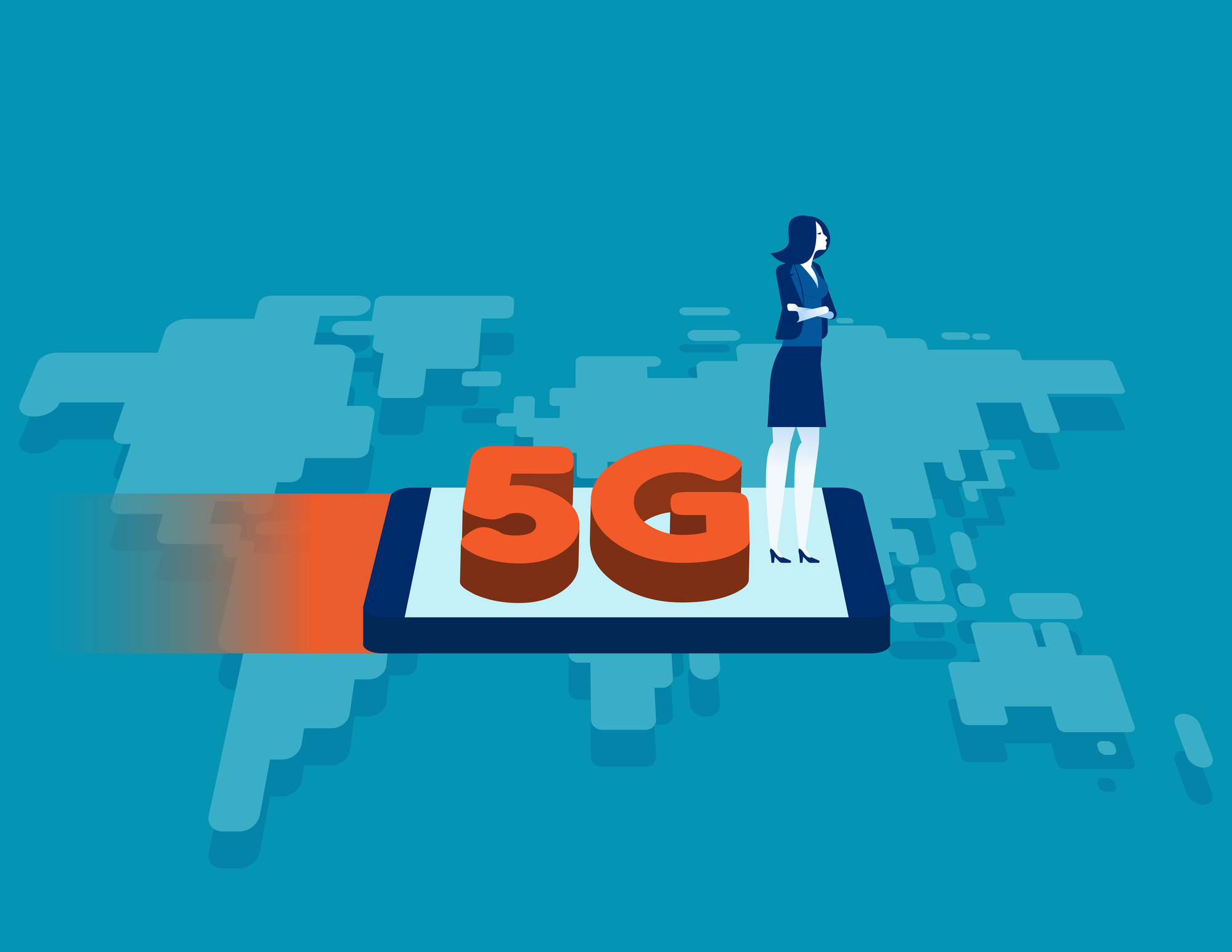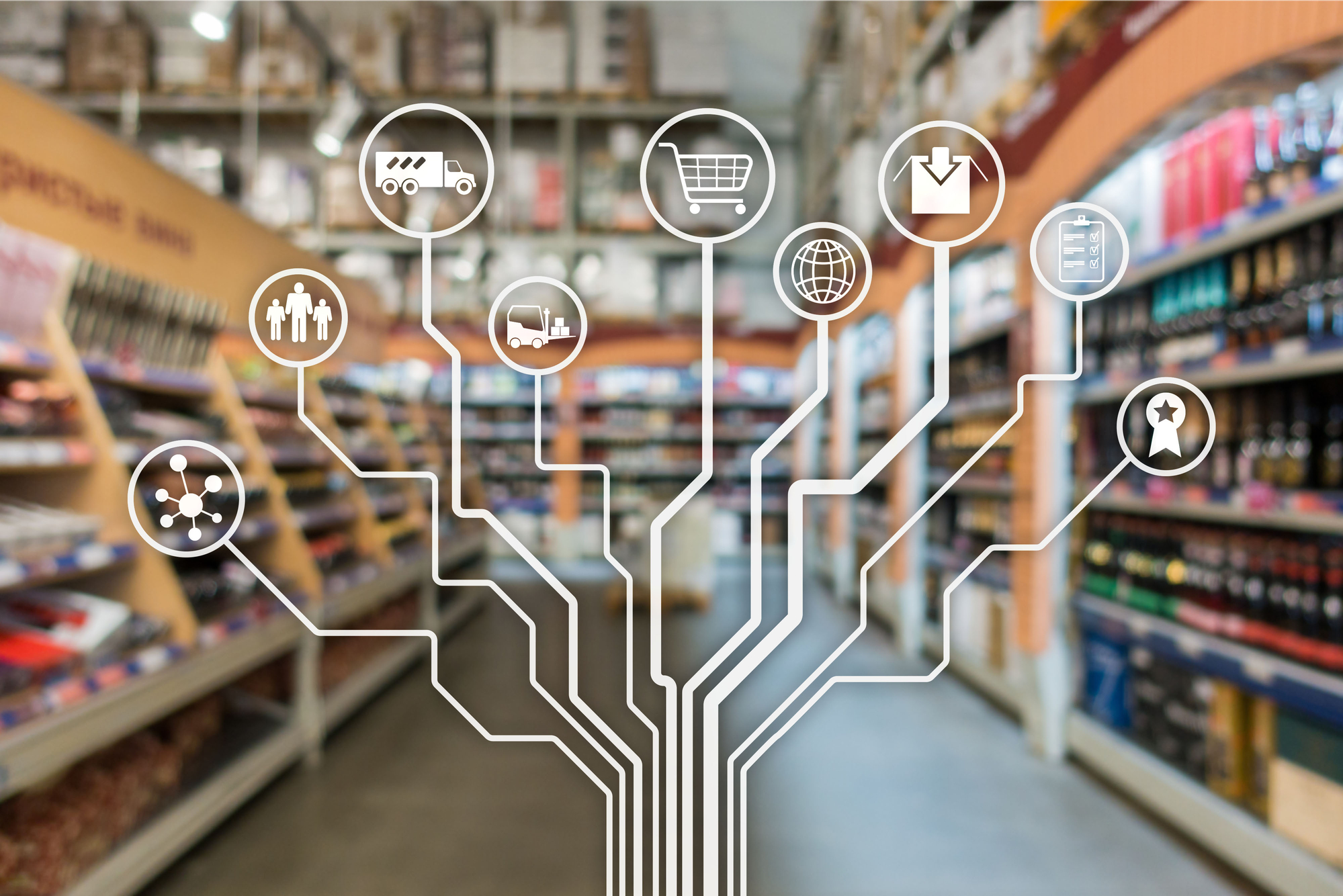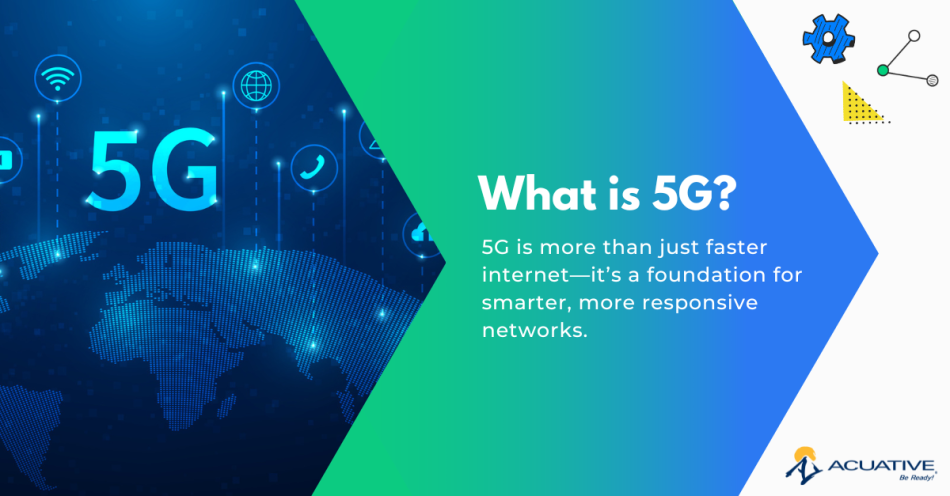George Segrest
5G, the fifth generation of wireless technology, is revolutionizing how we connect and communicate. Unlike its predecessor, 4G, 5G offers ultra-fast speeds, low latency, and massive device connectivity. This makes it a critical foundation for modern innovations, including autonomous vehicles, smart cities, and real-time business applications. For businesses, 5G is more than just faster internet—it’s an enabler of transformative technologies.
Contents:
- Key Features of 5G
- How Fast is 5G?
- Benefits of 5G Networks
- Challenges and Limitations of 5G
- 5G vs. 4G: What’s the Difference?
- 5G vs. Wi-Fi and Other WAN/LAN Options
- How to Leverage 5G for Business Success
- The Future of 5G
- FAQ
- Elevate Your Business with Cutting-Edge 5G Services
Key Features of 5G
5G technology operates using a combination of higher frequency radio waves and advanced antenna designs to deliver faster speeds and more reliable connectivity. Unlike 4G, which primarily utilizes low and mid-band frequencies, 5G leverages a wider range of the spectrum, including high-band millimeter waves. This allows for greater data capacity and faster transmission, though it also necessitates a denser network of small cell towers to ensure consistent coverage.
- Enhanced Mobile Broadband (eMBB): Provides faster speeds and increased capacity for users, enabling seamless streaming, gaming, and other high-bandwidth activities.
- Massive Machine-Type Communication (mMTC): Supports a large number of IoT devices simultaneously, making it possible to connect smart appliances, vehicles, and industrial sensors without network congestion.
- Ultra-Reliable Low Latency Communication (URLLC): Enables real-time applications like remote surgery, autonomous vehicles, and advanced manufacturing processes by minimizing lag to under 1 millisecond.
These features collectively make 5G a transformative technology for both consumers and businesses, paving the way for innovative applications and improved connectivity across all sectors.
How Fast is 5G?
One of the standout features of 5G is its speed. While 4G networks provide download speeds of up to 100 Mbps, 5G can achieve speeds exceeding 10 Gbps. This dramatic increase in speed supports data-intensive applications like augmented reality (AR), AI-powered applications like autonomous checkout, virtual reality (VR), and supply chain visibility. Additionally, 5G networks reduce latency to under 1 millisecond, ensuring near-instantaneous data transmission—a critical factor for applications requiring real-time responsiveness.
Benefits of 5G Networks
The benefits of 5G networks are transformative, making them essential for both businesses and consumers in 2025.
Faster Data Speeds: 5G networks can handle high-bandwidth applications with unparalleled efficiency. Whether it's streaming ultra-high-definition videos, running AR/VR experiences, or processing large datasets in real-time, the speed of 5G ensures these activities are seamless and lag-free. This makes it possible to support demanding tasks that were once beyond the capabilities of earlier networks.
Improved Connectivity: One of the most significant advantages of 5G is its ability to provide consistent performance even in densely populated areas. With the proliferation of connected devices, such as smart home devices and IoT systems, 5G ensures that all devices can communicate efficiently without congestion. This reliability extends to both urban centers and remote regions, bridging connectivity gaps that previously limited digital inclusion.
Enhanced Reliability: For mission-critical applications, such as remote healthcare, autonomous vehicles, and industrial automation, 5G’s robust reliability is crucial. The network's low latency and dependable performance ensure that essential systems operate without interruptions, enhancing safety, productivity, and overall user confidence.
Enhanced Security: 5G brings significant advancements in network security, leveraging modern encryption protocols, enhanced user authentication, and advanced threat detection mechanisms. Features like network slicing allow for the creation of isolated virtual networks within a 5G infrastructure, ensuring that sensitive operations, such as financial transactions or healthcare data exchanges, remain secure and insulated from potential threats. Additionally, 5G’s lower latency and higher bandwidth enable real-time threat monitoring and response, allowing organizations to identify and address vulnerabilities more effectively.
These benefits collectively position 5G as a cornerstone for modern digital transformation initiatives, driving innovation and unlocking new possibilities across various industries.
Challenges and Limitations of 5G
While 5G offers groundbreaking advantages, it also presents certain challenges that need to be addressed to maximize its potential.
Infrastructure Requirements: Deploying 5G networks requires significant investment in infrastructure, including new towers, small cells, and fiber optic backhaul systems. Unlike 4G, which relies on fewer, larger cell towers, 5G networks need a denser distribution of smaller cells to deliver high-speed connectivity. This poses logistical and financial challenges, especially in rural or underdeveloped areas.
Cost Implications: For businesses and consumers alike, the adoption of 5G can come with higher costs. Upgrading to 5G-compatible devices, whether smartphones, IoT systems, or industrial equipment, requires an upfront investment. Additionally, businesses may face ongoing expenses for network upgrades and advanced security measures.
Security Concerns: As 5G expands the number of connected devices, it also increases the attack surface for cyber threats. From IoT vulnerabilities to potential breaches in critical systems, ensuring the security of 5G networks is paramount. Advanced encryption, network segmentation, and real-time monitoring are essential to mitigate these risks and protect users from evolving threats.
By addressing these challenges proactively, stakeholders can unlock the full potential of 5G while minimizing potential drawbacks.
5G vs. 4G: What’s the Difference?
The transition from 4G to 5G marks a significant leap in wireless technology.
Speed: One of the most noticeable differences is the dramatic increase in speed. While 4G can provide download speeds up to 100 Mbps, 5G surpasses this with speeds exceeding 10 Gbps. This level of performance enables instantaneous downloads, real-time streaming of 4K and 8K video content, and smoother operation of complex applications.
Capacity: The capacity of 5G networks is another key improvement. 5G can support far more devices per square mile than 4G, making it ideal for environments where connectivity demand is high. This ensures seamless operation in crowded areas like stadiums, concert venues, and urban hubs where traditional networks often struggle.
Latency: The reduced latency of 5G is a game-changer. While 4G networks typically experience latency of 30-50 milliseconds, 5G slashes this to under 1 millisecond. This near-instantaneous response time is vital for applications like autonomous vehicles, remote-controlled machinery, and augmented reality experiences, where even a slight delay can have significant consequences.
These advancements expand the range of applications for wireless technology, paving the way for innovations in smart homes, connected vehicles, and beyond.
5G vs. Wi-Fi and Other WAN/LAN Options
5G represents a transformative leap in connectivity, offering several advantages over traditional WAN, LAN, and Wi-Fi solutions. While each technology has its strengths, 5G excels in delivering faster speeds, lower latency, and unparalleled flexibility, making it a compelling choice for businesses in industries like retail, banking, and healthcare. Private cellular network are dedicated, localized wireless networks that operates using cellular technology, such as 4G LTE or 5G, but is separate from public mobile networks. Private cellular networks offer businesses a dedicated, secure alternative to traditional Wi-Fi and WAN/LAN options. These networks operate on dedicated spectrum, providing reliable, high-performance connectivity with low latency and predictable speeds.
Compared to traditional WAN options like MPLS or LTE, 5G provides significantly higher bandwidth, enabling faster data transfer. 5G’s low latency (as little as 1 millisecond in optimal conditions) supports time-sensitive operations, such as live inventory updates in retail or financial trading systems in banking. Unlike MPLS, which requires complex infrastructure, 5G allows for quicker deployment and greater adaptability in dynamic business environments.
Against wired LANs, 5G eliminates the need for physical infrastructure, enabling mobility and scalability that are critical in industries with distributed operations. For example, in retail, pop-up stores and mobile payment systems can leverage 5G for instant connectivity. In healthcare, 5G can support portable diagnostic equipment and telemedicine services in rural or temporary locations, where LAN setups would be impractical.
When compared to Wi-Fi, 5G offers broader coverage, better performance in dense environments, and more robust security. Wi-Fi excels in localized settings, such as small offices or specific building floors, but 5G is better suited for environments requiring reliable connectivity across larger areas. In retail, this means connecting multiple in-store IoT devices, such as smart shelves and customer tracking systems, without interference. For banking, 5G’s enhanced security features ensure safe mobile transactions. In healthcare, 5G can support critical applications like remote surgeries and real-time patient monitoring, where uninterrupted connectivity is vital.
By combining the strengths of speed, mobility, and scalability, 5G empowers industries to embrace innovative use cases and future-proof their operations. Its ability to seamlessly connect people, devices, and systems positions 5G as a cornerstone technology for the digital transformation of retail, banking, healthcare, and beyond.

How to Leverage 5G for Business Success
Industries like healthcare, manufacturing, and retail are already unlocking the potential of 5G to drive efficiencies and improve outcomes. In retail, 5G powers enhanced customer experiences with smart shelves and IoT-enabled inventory management systems that update stock levels in real-time, reducing waste and streamlining supply chains. It also supports advanced AR experiences, letting customers virtually try on clothes or visualize furniture in their homes. In manufacturing, 5G-connected IoT devices enable predictive maintenance and optimize factory operations by minimizing downtime. Healthcare is transforming with telemedicine, where high-speed, low-latency 5G enables virtual consultations and even remote surgeries with unmatched precision.
The question is: how can your business tap into the transformative power of 5G? Whether you're looking to enhance customer experiences, streamline operations, or enable new services, 5G offers a wealth of possibilities to explore.
- Integrate 5G into Operations: Upgrade to 5G-compatible devices and services, ensuring seamless integration with existing workflows. This may include investing in IoT devices, enhancing cloud capabilities, and optimizing network infrastructure for 5G compatibility.
- Partner with Providers: Collaborate with managed service providers to access tailored 5G solutions that meet your unique business needs. Consider solutions that prioritize high bandwidth, security, and scalability for future growth.
- Evaluate ROI: Regularly monitor the impact of 5G adoption on productivity, operational efficiency, and customer satisfaction. Utilize analytics tools to measure the tangible benefits and identify areas for further optimization.
- Explore New Opportunities: Use 5G capabilities to innovate within your industry. Develop applications that leverage real-time data processing, augmented reality, or automation to enhance customer experience and create competitive advantages.
- Train Your Workforce: Educate employees on how to use new 5G-enabled tools and processes effectively. Building technical proficiency ensures that your team can fully leverage the benefits of 5G technology.
The Future of 5G
The future of 5G is intricately connected to the advancement of emerging technologies such as artificial intelligence (AI), the Internet of Things (IoT), and edge computing. These technologies are poised to redefine the way industries operate and individuals experience connectivity.
As 5G networks expand, they will support the creation of smart cities, where enhanced connectivity fosters efficient urban planning, real-time traffic management, and advanced public services. Autonomous vehicles will benefit from 5G’s real-time data exchange capabilities, allowing for safer and more responsive transportation systems. Similarly, telemedicine is set to thrive with the availability of high-quality remote healthcare services, enabling doctors to perform virtual consultations and even remote surgeries with precision.
Moreover, the integration of 5G with AI and edge computing will pave the way for faster and more reliable decision-making processes across industries. Experts predict that this synergy will not only reshape industries but also enhance quality of life and stimulate economic growth globally over the next decade.
FAQs about 5G
- Does 5G require new devices or infrastructure? Yes, to fully benefit from 5G, businesses need 5G-enabled devices and compatible infrastructure, such as upgraded routers, IoT devices, and possibly small cell installations for mmWave coverage. However, many devices are backward compatible, allowing a phased adoption.
- Is 5G safe? Yes, 5G complies with international safety standards. Concerns about radiofrequency (RF) exposure have been thoroughly studied, and 5G operates within established safety limits, similar to existing cellular networks.
- How can 5G improve hybrid work environments? 5G enhances hybrid work by providing high-speed, low-latency connectivity for remote workers, enabling seamless video conferencing, real-time collaboration, and access to cloud-based applications. It also supports secure mobile connections for employees on the go.
- Will 5G be available in rural areas? 5G is being rolled out in phases, and while urban areas are typically the first to benefit, rural coverage is expanding. The use of low-band 5G frequencies will help provide coverage in less densely populated areas, although high-speed services may still be limited in certain regions.
- How does 5G impact data privacy? 5G introduces enhanced encryption and authentication features, improving the protection of data during transmission. However, as more devices become connected, data privacy challenges grow. Businesses will need to adopt robust data privacy policies and implement security solutions like secure network slicing to ensure compliance with privacy regulations.
- What is 5G UC? 5G UC, or Ultra Capacity, refers to a premium tier of 5G services offering faster speeds and greater reliability, coined by T-Mobile. Unlike standard 5G, which can operate on low-band frequencies, 5G UC exclusively utilizes mid-band and mmWave frequencies to deliver superior performance. This makes 5G UC ideal for urban areas and high-demand environments where speed and capacity are crucial.
Elevate Your Business with Cutting-Edge 5G Services
At Acuative, we understand the transformative potential of 5G technology and how it can revolutionize your business operations. Our Managed 5G Services provide end-to-end solutions, including expert consultation, seamless installation, full implementation, and ongoing management. We help businesses unlock the power of 5G by ensuring a smooth transition from traditional networks to next-generation connectivity.
Our experienced team works closely with you to assess your unique needs, design customized solutions, and handle all aspects of 5G deployment. With our managed services, you can focus on growing your business while we manage the complexities of 5G infrastructure, ensuring reliability, scalability, and security throughout your network.
Let Acuative guide you through the 5G revolution and help your business stay ahead of the curve.
About George Segrest
With over 30 years of expertise in sales in the managed services industry, I've developed expertise on infrastructure, cloud, cybersecurity, and DevOps, and I have witnessed firsthand the transformative power of innovation. As a technology enthusiast with a deep understanding of how businesses leverage technology to drive growth, I was excited to explore the transformative potential of 5G cellular networks. By exploring the key advantages of 5G, including its impact on areas such as industrial automation, IoT, and remote work, my goal is to show how businesses can capitalize on this groundbreaking technology.

